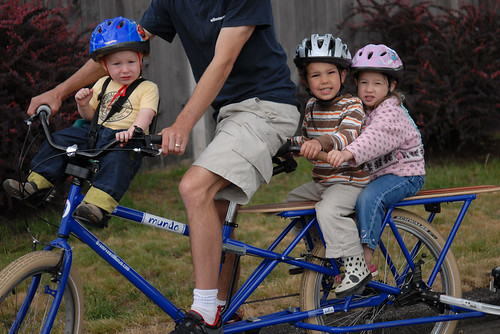
(Photos © J. Maus/BikePortland)
The Yuba Mundo, a longtail cargo bike popular in the Portland area, has been recalled by the manufacturer due to a safety hazard. According to a recall notice posted by the Consumer Product Safety Commission, passengers riding on the back of the Mundo (especially children) can get their feet caught in the wheel. Yuba is aware of two such incidents and they are now providing free skirt guards (wheelcovers) to all their dealers.
Here’s the flyer posted by Yuba:
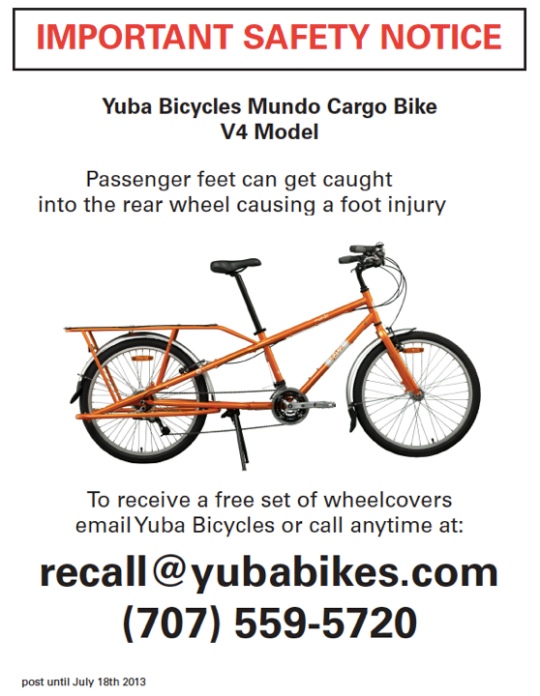
The Mundo debuted in Portland in May 2008 and has found a solid market here due to its very stable handling even with heavy loads (I tested the Mundo in June 2006). Joe Bike, a retailer with shops on SE Hawthorne and SE Cesar Chavez Blvd, is the largest Yuba Mundo dealer in the world. Joe Bike owner Joe Doebele posted a message on Twitter about the recall on Sunday.
“It used to be common knowledge among kids (and parents) that you keep your feet out of the spokes when you’re getting a ride, but it seems like this common sense has been lost in America,” Doebele shared this morning via email. Doebele urges all Mundo owners to stop into his shop for a set of wheelcovers. The covers prevent feet from getting caught in the spokes. “Skirt guards should be used not just on the Mundo but on any longtail bike that carries kids.”
Many Mundo owners (like the family in the photo below) have large cargo bags attached to the rear rack which prevent feet from getting caught.
You can read more about the recall and learn what to do if your bike is impacted at YubaBikes.com.



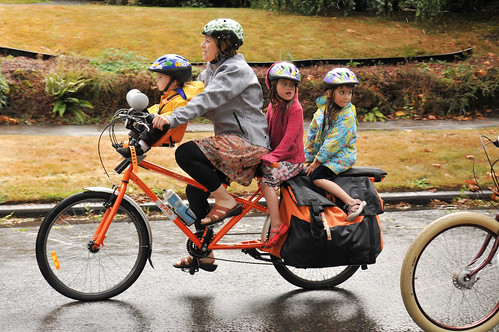
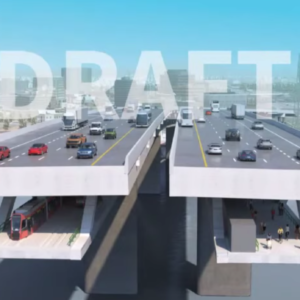


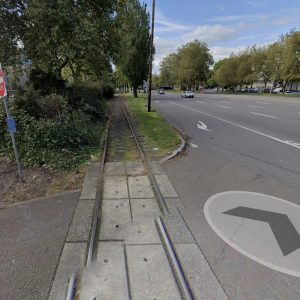
Thanks for reading.
BikePortland has served this community with independent community journalism since 2005. We rely on subscriptions from readers like you to survive. Your financial support is vital in keeping this valuable resource alive and well.
Please subscribe today to strengthen and expand our work.
awesome photo little man up front looks sad he wants to pedal. haha
That Joe Bike quote is a little patronizing. Young kids who get their feet caught in spokes are an example common sense being lost in America? They’re just kids! Kids are not adults in tiny bodies. They haven’t learned common sense yet 🙂
I’m glad to see that the skirt guards are available now and that the problem has such an easy solution.
Also, even if this “common sense” premise were true, there have only been two reports of feet getting caught, and no injuries… out of the hundreds/thousands of owners of Yuba Mundos, this is seemingly a very rare occurrence. So it looks like the vast, vast majority still have their “common sense” intact.
But seriously, these exposed wheels would be a potential hazard at any time in history. The difference is in the distant past, the CPSC didn’t exist, and the manufacturer probably wouldn’t have bothered with a recall.
I think side skirts make sense on any bike where bodies or clothing are very close to the rear wheel, but I’m kind of paranoid. They’re pretty ubiquitous on Dutch bikes.
Other people should not have to save you from yourself.
Presumably common sense would tell the adult pedaling the bike that kids feet are at risk of getting caught in the wheel and maybe something should be done to prevent that from happening.
I agree that Joe’s comment is patronizing. We’re talking about little kids here. Did they really not think to even offer skirt guards?
They already offered them, though not for the earliest version…for that they give you a pattern and say D.I.Y.
One of my grandparents’ bike safety stories had one my mother’s contemporaries losing his toe as a passenger on a bicycle. It seems like the kids in their youth were always losing body parts, my grandfather’s missing finger adding gravity and credibility to their warnings. Come to think of it, this probably has something to do with my aversion to flip-flops.
Back in the day I snipped off the end of my toe with bike spokes. Bled like a son of a gun. I guess I learned “common sense” that day.
For the record, the kids in the picture of the unprotected bike still have all of their toes. As do all of the other kids I’ve given rides to on my Mundo. There have been a few cases of shoes getting chewed up by the spokes and I think I’ll be picking up those wheel covers.
awesome Tim BTW I was not worried at all, raising my son bybike and having all kinds of ppl telling me how to do it. * even police pulling me over waaaay back 18+ years ago. keep rolling everyone!
How is the Mundo different from any other longtail?
The Mundo is often sold without bags. You won’t see many bagless Xtracycles, and I never see anyone riding a ute or transport.
I mangled my ankle while riding on the back of my Dad’s circa 1965 Schwinn Tiger. He told me what was up, I just experimented a little with relaxing my legs. So, I agree: make the bikes “kid-proof”.
And yes, most longtails aren’t ridden without defacto wheel guards (bags) and historically, Yuba Mundos HAVE NOT offered any way to carry two children WITH bags. That combined with the massive family usage of Mundos creates this somewhat predictable scenario.
I don’t mean to be picky, but do people really ride with their kids on the back of these things? No real seats or handlebars to hang on to that I can see. And the exposure to the spokes seems like an accident waiting to happen.
They do, Steve.
And the world over. In most countries where bikes are (still) a more common mode of transport the degree of ‘overloading’ (and your sense of uncertified use) would probably be even higher
Yes, Steve, and my Yuba has real seats and real handle bars.
There is nothing “safe” about riding a big, heavy, rim-brake equipped bicycle with multiple passengers in traffic. I wholeheartedly support people’s right to do dumbass things to themselves; but, I question the lessons that these parents are teaching their kids about the “safety” of our full-contact world.
I thought we were done with this sort of thing.
The record-breaking Emily Finch discussion here featured plenty of this finger-wagging do you realize how dangerous your biking is! Think of the children! talk. I doubt you really want to go down this road; compare statistical probabilities of injury associated with various modes of transport.
Hear, hear.
There really needs to be a recall for this? The obvious occurs and the government needs to get involved, this is absurd. Personally, I could care less about the health of children. I care about these future adults moving through our increasingly dangerous world with screwball attitudes about “safety” learned from dingbats.
I would love to be directed towards comparative statistical data concerning novelty bikes, overloaded bikes, or bikes with multiple passengers interacting with traffic vs. single passenger bikes with reasonable loads and good brakes.
I don’t think there is any way to slice data on fatalities or injuries in traffic that shows anything but that cars and speed are overwhelmingly responsible. I suspect that the overloaded bikes are dangerous idea does not lead to deaths and probably rather few serious injuries the world over. Here are a few sources on the slightly larger but more readily studied comparison of vulnerabilities of those in cars and not in cars:
http://t4america.org/resources/dangerousbydesign2011/
Solving the Epidemic of Preventable Pedestrian Deaths
The decades-long neglect of pedestrian safety in the design and use of American streets is exacting a heavy toll on our lives. In the last decade, from 2000 through 2009, more than 47,700 pedestrians were killed in the United States, the equivalent of a jumbo jet full of passengers crashing roughly every month. On top of that, more than 688,000 pedestrians were injured over the decade, a number equivalent to a pedestrian being struck by a car or truck every 7 minutes.
Despite the magnitude of these avoidable tragedies, little public attention – and even less in public resources – has been committed to reducing pedestrian deaths and injuries in the United States. On the contrary, transportation agencies typically prioritize speeding traffic over the safety of people on foot or other vulnerable road users.
Nationwide, pedestrians account for nearly 12 percent of total traffic deaths. But state departments of transportation have largely ignored pedestrian safety from a budgetary perspective, allocating only about 1.5 percent of available federal funds to projects that retrofit dangerous roads or create safe alternatives.
http://www.rightofway.org/research/kba.html
In 1999, Charlie Komanoff of the group Right of Way published Killed by Automobile, the first comprehensive analysis of pedestrian and cyclist fatalities in New York City. Charlie reviewed four years’ worth of police reports concerning hundreds of deaths. The reports showed that drivers were legally culpable some 74 percent of the time. They also showed that only one-fourth of those motorists were even cited for traffic violation. I repeat, most drivers whose illegal actions killed people didn’t get so much as a ticket.
http://freakonomics.blogs.nytimes.com/2009/08/28/who-causes-cyclists-deaths/?emc=eta1
“More than 52,000 bicyclists have been killed in bicycle traffic accidents in the U.S. over the 80 years the federal government has been keeping records. When it comes to sharing the road with cars, many people seem to assume that such accidents are usually the cyclist’s fault, a result of reckless or aggressive riding. But an analysis of police reports on 2,752 bike-car accidents in Toronto found that clumsy or inattentive driving by motorists was the cause of 90 percent of these crashes.”
http://www.who.int/violence_injury_prevention/road_safety_status/2013/en/index.html
The increasing number of motorized vehicles makes roads more dangerous for those road users who use alternative modes of transport – notably those who walk, cycle and use motorcycles.
…and a whole lot more amazing statistics:
http://bicycleuniverse.info/transpo/almanac-safety.html
here’s just one of many many facts enumerated on this page:
Speeding. The Wisconsin State Journal points out that everyone is focused on the danger of drunk driving, while speeding is potentially an even bigger problem.
Yes, “everybody does it” – or at least 71 percent of licensed drivers, according to the American Automobile Association. Nationwide, 13,713 died last year [2003] in accidents caused by speeding. That’s about 400 more fatalities than were caused by drunken driving in 2002.
Moreover, while the number of drunken driving fatalities has fallen 37 percent nationwide in the past 20 years, the number of fatal accidents has been rising steadily in the 22 states that have raised their speed limits to 70 mph or more since 1995. Safety experts say the risk of death in a crash doubles for every 10-mph increase in speed.
You’re asking for studies of the trees, not the forest. Those things that you wonder about are not significant safety factors. Things that are:
For young people, driving vs biking, driving is more dangerous.
http://www.ucl.ac.uk/news/news-articles/1212/06122012-cycling-risk
For adults, driving to work versus biking to work, driving is more dangerous (39% higher mortality rate — “more dangerous”, unless you think heart attacks and strokes are “safe”)
For other people (pedestrians, e.g.) bicycles are far safer than cars; per vehicle, about 15x.
Loaded bikes and bikes carrying children are far more common in the Netherlands, yet cyclists there are the safest in the world. The presence of a load on the bike is not a major factor in safety; other things matter much more.
Speaking anecdotally, when loaded, I tend to not move so fast. Reduced speed tends to make crashes much safer. In addition, when riding a heavy bike it becomes somewhat easier to handle in a minor collision because the bike itself (being heavier) reacts less violently to the impact. I’ve also been putting in most of my miles on a cargo bike for the last six years, and dangerous loss of control has not been a problem, even when loaded (it can be difficult to handle, but you are not surprised when this happens, and you compensate — in particular, you ride more slowly, which vastly increases safety).
Interacting with automobiles is the most dangerous thing that humans do on a daily basis for sure, so why do people consistently behave otherwise? There appears to be nothing that can be done to make people drive motorized vehicles safely. So, either you can reduce the number of those interactions with automobiles, or you can mitigate the dangerousness of those interactions by using “commonsense.” The “safest” bicycle is the one that you have the most control of, one that is appropriate for existing conditions and the rider’s skill; because of the lack of mechanical assistance (relative to autos) bicycling safely also requires a minimum of fitness. The more interference you add between any vehicle and its operator the more dangerous it is going to be. There is no such thing as “multi-tasking”, it is just an increase in physical and cognitive load, and this measurably diminishes performance- amplifying the risk of accidents. Riding a cargo/long-tail bike with three children on it is about as safe as riding a tall bike while talking on a cell phone. It can be done numerous times without incident, but are the risks worth it? Would it be OK to put three kids on a motorcycle?
The comparison between North American traffic and that of the Netherlands doesn’t seem cogent. Beyond the demographic and geographic differences, in my experience North American urban traffic, while not as bad, is more like what you would find in city in South/Central America, Africa, China, or in a European city like Rome. In those places riding a bicycle with a load is a risky activity, and the statistical evidence will reflect that.
Like I said, I fully respect people’s right to do stupid things to themselves, but leave the authorities out of it. You don’t need to call the government because you did something stupid, just like you don’t need to call the cops because you saw an upsetting movie.
The easiest way to make the world a “safe” place is by being well prepared for what it is going to throw at you; safety is a learned habit. Portland’s traffic is easier to navigate than most places, but if these kids learn a bunch of stupid habits and take them into the wider world they are going to be in trouble. Just because it is your “right” to march out in front of traffic, doesn’t mean it is a smart thing to do; and, doing so can quickly get you a toe-tag. The fact that some ‘recall’ had to be enacted, when the risk is so obvious, is ridiculous. We should be less worried about the equipment being used than the minds of the people using it (and particularly the pedagogical influence of those minds). It’s no wonder that so many of these kids are baffled entering into adulthood and finding that the world is not some object exclusively designed for their pleasure.
While widespread use of these cargo bikes as mechanical babysitters for the petty Bourgeois might be good for Joe’s business it may not be good for bicycling. If people get injured because of their lack of “commonsense”, and there are enough lawsuits; we are going to end up being required to have side impact protection and airbags on our bicycles. I am convinced we are one headline grabbing, tragic accident away from some serious legislation because somebody throws their kids in a wheelbarrow bike, to go parading around in traffic, and thinks it is going to handle like a Pinarello. I get seriously irritated when things that important to me are negatively impacted by other people’s stupidity.
Safety is no accident!
“While widespread use of these cargo bikes as mechanical babysitters for the petty Bourgeois might be good for Joe’s business it may not be good for bicycling.”
Ouch.
What does getting feet caught in spokes have to do with riding in traffic? You seem to be ranting about the stupidity of both, when the article was only about the former.
Nope. The safest bicycle is one that hangs in the garage and never gets used–but you might still hit your head on it.
So, it appears you assume that most or all cargo bike operator lack the minimum skill set or fitness level needed to use it safely. That’s your assumption; maybe you are projecting your own lack of skill onto others. You also imply that cargo bikes are “overloaded”, when loading them up (to a point) is what they are actually designed for.
So you are comparing cargo bikes to motorcycles, but it isn’t “cogent” to compare North American traffic to Dutch traffic?
So, people are afraid of getting their feet caught in the spokes of a Pinarello? Oh, wait–this refers to your unrelated rant. Again, you seem to be assuming pervasive lack of skill on the part of of cargo bike operators. Do you ascribe the same low I.Q. expectations and lack of skill to operators of baby strollers? After all, pedestrians get run over all the time. Don’t parents who push their little cherubs around in strollers assume that the stroller will handle like a pair of Nikes(tm)? For that matter, I’ve seen parents with top-heavy SUVs strap their kids in there and then tear around thinking their Expedition will handle like a Ferrari.
Your string of comments smacks of car-head.
Kinda funny that he thinks a Pinarello is the benchmark for a safe bicycle, too. Skinny underspoked wheels can get caught in road slots, collapse if they hit a curb or pothole too hard, head-down reduces your visibility to traffic and pushes you a little closer to flipping if you brake hard (cargo bikes tend to have their center-of-mass lower and further back, more like a tandem). That speedy aero posture leads to higher-speed crashes when they finally do occur. Skimping on materials to save weight leads to handlebars that can be torn right in half; I’ve found (twice) that this does not enhance the bike’s handling.
Those tight-built bikes are twitchy, too; there’s a lot to be said for stability.
In light of a recent winter-cargo-biking discussion (other coast, where we have winter), one thing I realized was that the cargo bikes are often much more forgiving in adversity. Longer bikes go into slides etc more slowly, giving you more time to react and a better chance of reacting sensibly. This is the sort of thing you notice on snow and ice — surprises happen much more quickly on a short bike, where on a long tail you have time to deal with it. (I have experience doing powerslides on long and short bikes — long is much, much easier to manage.)
“Interacting with automobiles is the most dangerous thing that humans do on a daily basis for sure, so why do people consistently behave otherwise? ”
Are you talking about the people inside the cars, near the steering wheel, or those outside the car?
9 watts: all of the above.
El Biciclero: I think riding with multiple children on a motorcycle vs. bicycle is more analogous than urban traffic conditions in the average Dutch vs. U.S city, especially if people are talking about Amsterdam when referring to the Netherlands. There isn’t a hill the size of MT. Tabor within hundreds of miles of that city.
Are children cargo? Most cargo doesn’t squirm, talk, or get traumatic brain injuries. And, yes I am biased- the people in my neighborhood that I see hauling children around on cargo bikes seem to be of the low-skill, minimal-fitness set. Which is perfectly fine on a bike path or in a park, but riding a bicycle on a street with cars is potentially dangerous. Personally, I could give a rat’s ass whether someone’s kid gets hurt, my concern is the possibility of that injury leading to legislation that would put limits on my bicycle riding. My concerns are purely selfish.
And if you want to go riding, I should be at the a.m. BMX session at Burnside Thursday or Friday, depending on work.
quote:
There appears to be nothing that can be done to make people drive motorized vehicles safely. So, either you can reduce the number of those interactions with automobiles, or you can mitigate the dangerousness of those interactions by using “commonsense.”
endquote.
seems to me a commonsense way to reduce the number of interactions would be to greatly reduce the number of people who are permitted to operate motor vehicles on public roadways.
Uh, no, Joe, back in the “common sense” days foot and ankle injuries, often severe, from kid-on-back-no-spoke-guard were not rare, as reported in various European and US medical journals of the time.
There was actually a heel injury at the first Fiets of Parenthood from a spoke incident, can’t remember if it was a mundo though.
“Common sense” here would have been to not let Mundos (and midtails) out the door without bags or spoke guards ($30, should have been standard), if kids were going to be riding on the back.
Okay everybody, I have to agree the “common sense” quote was at least flip, and I wish I could take it back. In fact, I wished so right away. But I made it pretty clear that the skirt guards are a good idea in any case, for any longtail or any bike where kids ride on the rear. Thanks.
Actually Joe, I am going to come to your defense a bit. These are cargo bikes, not intended as designed to carry children hanging like baby bonobo’s off the back. I have no problem with them being ridden in this fashion, as I am NOT a nanny-stater prude by any stretch. It would however behoove any parent (btw I am one) to make aware the inherent danger to their kids with due diligence… often. Of course accidents do happen. I for one failed horribly to properly pin the trail-a-bike once, much to my 4 year olds chagrin! He was pee’d off to say the least.
Is the recall only for the V4, as the image of the notice above seems to specify?
Guess so:
http://www.cpsc.gov/en/Recalls/2013/Yuba-Bicycles-Recalls-Mundo-Cargo-Bikes/
well, duh. we have a mundo & had guards put on when we bought it, what responsible adult Wouldn’t see that as a risk? And it shouldn’t be standard b/c not everyone uses them to haul kids around
Sorry but that looks like child abuse.
I support Joe’s comment. I think people need to be responsible for their own safety as well as their children. That being said, I think to society lacks common sense and is ready to blame someone else for their stupid mistakes.
Trouble is that intellectually challenged adults breed challenged children. Quit whining, get over it, and try employing some common sense and self responsibility.
While I agree in principle with the concept of using common sense in our daily lives, I actually see this as a fine turn of events because it lends a patina of respectability to bikes-as-transport.
If the CPSC looked into the Mundo (and cargo bikes) and all they found wanting was the lack of “wheelskirts”, I think bikes may soon be considered a normal form of transport. If even the people that need “Contents may be hot” warnings on McCoffee cups can operate a longtail bike, biking IS mainstream.
That is a very astute observation. And a far cry from the ‘it is illegal to carry any passengers on your bike’ nonsense we were hearing only recently.
mcdonald’s coffee is much too hot
Yuba Mundo- what a dog! This bike does not carry loads well. Just get a Wald basket, you’ll be able to carry all kinds of outsize items. Trust me, I’ve been car free for over 20 years.